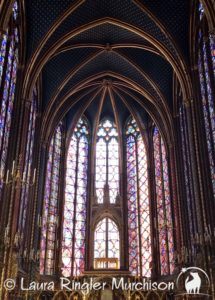
This was my third trip to Paris and on our last trip we discovered what instantly became my favorite church in the entire world — Sainte-Chapelle; the Holy Chapel. It was a royal chapel built in the Gothic style within the medieval Palais de la Cité, the residence of the Kings of France until the 14th century. It is located in the Île de la Cité in the heart of Paris, which is one of two remaining natural islands on the Seine; the other is the Île Saint-Louis. Sainte-Chapelle is considered among the highest of architectural achievements, commissioned by King Louis IX to house his collection of the relics of Christ, including the Crown of Thorns, one of the most important pieces in all Christendom. Although damaged during the French Revolution, the chapel was restored in the 19th century and contains one of the most extensive collections of 13th century stained glass in the world. The King purchased his Passion relics from Baldwin II, the Latin emperor at Constantinople, for the sum of 135,000 livres. His money was actually paid to the Venetians, to whom the relics had been pawned. They arrived in Paris in 1239, carried from Venice by two Dominican friars. For the final stage of their journey they were carried by the King himself, barefoot and dressed as a penitent. A scene depicting the Relics of the Passion can be seen on a south side window of the chapel. The relics were stored in a large, elaborate silver chest, the Grand-Chasse, on which King Louis spent another 100,000 livres. The entire chapel, by contrast, cost only 40,000 livres to build. It is truly the most magnificent church I have ever had the privilege of seeing. And it lies in relative obscurity just several blocks away from Notre Dame. In 1246 fragments of the True Cross (on which Jesus was crucified) and the Holy Lance (the spear that pierced the side of Jesus as he hung on the cross) were added to the King’s collection along with other relics. The chapel was consecrated in 1248. Just as the Emperor of Constantinople could privately pass between his palace into the Hagia Sophia, so now King Louis could go directly from his palace into the Sainte-Chapelle. The two-story chapel has obvious similarities between Charlemagne’s palatine chapel, a parallel that Louis was keen to exploit in presenting himself as a worthy successor to the first Holy Roman Emperor. The chapel itself seems like a reliquary turned inside out, with the richest decoration on the inside. I suppose that is one of the reasons why I love it so. Each shaft separating the great windows depict the twelve larger-than-life sized apostles. The most famous features of the holy chapel, the stained glass, reduce the stone wall surface to little more than a delicate framework. The chapel tragically suffered its most grievous destruction during the late 18th century in the French Revolution. It has been a national historic monument since 1862. The principal of the Gothic architectural revolution in 13th-century Europe suggests heaviness, darkness, and a brooding past. Sainte-Chapelle irradiates that cliché and is a stroke of brilliant practical engineering. It is a miracle of light and there is nothing I can say to describe the incredible beauty of this ‘small” chapel which King Louis of France had commissioned. My thought is that one could not build such an exquisite labor of love and not believe. It is like standing in the middle of a tremendously high crystal filled with every colored jewel imaginable. Each panel has meaning and tells the story of the Bible, beginning with Genesis. The early Christian theologian and philosopher, Saint Augustine, once said,
“Faith is to believe what you do not see; the reward of this faith is to see what you believe.”
One can stand right now in the midst of this Holy Chapel and be struck by awe. There is a simplicity of magnificence which can clearly be seen. For me there is also a palpable holiness which lingers. If faith is believing in that which is unseen, surely the earthly reward of Christian faith is present in Sainte-Chapelle.
